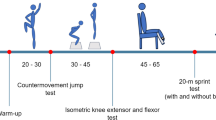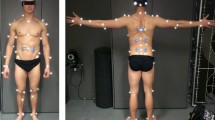Abstract
The ankle joints of 14 healthy volunteers and 16 patients with unstable ankle joints were tested regarding their functional and proprioceptive capabilities. All of them were active athletes. Three tests were used of the study: single-leg stance test, single-leg jumping course test, angle-reproduction test. The influence of three stabilization devices (lace-on-brace/“Mikros”, stirrup-brace/ “Aircast”, taping) on the proprioceptivity of stable and unstable ankle joints was evaluated. The scores of the singleleg jumping course without any stabilizing device (category “standard”) ranged between 8.06 and 13.68 (10.65±1.29). In the categories “Mikros” (9.85±0.99), and “Aircast” (9.99±1.14) as well as with the tape bandage (10.27±0.81) better scores were achieved. The differences “standard vs. Mikros” and “standard vs. Aircast” revealed a significant reduction of the scores with orthoses (P<0.01). The error rate in the single-leg stance test was within the range of 0–16 (5.12±2.85) for the category “standard”. It was lower for the categories “Mikros” (3.65±2.65) and “Aircast” (4.17±2.59). The error rate was highest in the group with a tape bandage (5.79±3.53). The differences “standard vs Mikros” as well as “standard vs. Aircast” were significant (P<0.01). There was also a significant difference between these categories regarding injured and not injured ankle joints (P<0.01). The angle-reproduction-test showed higher values for the category “standard” (2.36°±0.97) in comparison to the categories “Mikros” (1.46°±0.72), “Aircast” (1.62°±0.91) and “taping” (1.84°±0.41). In the category “standard” the reproduction error was lower testing not injured ankle joints (2.30°±1.04) than testing the group of unstable ankle joints (2.44°±0.81), whereas in all other categories the reproduction error was higher in the group of not injured joints. The differences in all measurements between “standard vs. Mikros” and “standard vs. Aircast” were significant (P<0.01). The results of the three tests showed a highly significant difference between injured and not injured ankle joints (P<0.01).
Similar content being viewed by others
References
Barrett JR, Tanji JL, Drake Ch, Fuller D, Kawasaki RI, Fenton RM (1993) High versus low-top shoes for prevention of ankle sprains in basketball players. Am J Sports Med 21: 582–585
Berenberg RA, Sheffner JM, Sabol JJ (1987) Quantitative assessment of position sense at the ankle: a functional approach. Neurology 37: 89–93
Biener K, Fasler S (1978) Sportunfälle—Epidemiologie und Prävention. Huber, Stuttgart Wien, pp 97–100
Bunch RP, Bednarski K, Holland D, Mancinanti R (1985) Ankle joint support: a comparison of re-usable Lace-on-Braces with taping and wrapping. Physician Sports Med 13: 59–62
Chambers RB, Cook TM, Cowell HR (1982) Surgical reconstruction for calcaneonavicular coalition. J Bone Joint Surg [Am] 64: 829–836
Corrigan JP, Cashmann WF, Brady MP (1992) Proprioception in the cruciate deficient knee. Bone Joint Surg [Br] 74: 247–250
Franke K (1980) Traumatologie des Sports. Thieme, Stuttgart, pp 45–49
Freeman MAR (1965) Treatment of ruptures of the lateral ligament of the ankle. J Bone Joint Surg [Br] 47: 661–668
Freeman MAR (1965) Instability of the foot after injuries to the lateral ligament of the ankle. J Bone Joint Surg [Br] 47: 669–677
Freeman MAR, Dean MRE, Hanham IWF (1965) The etiology and prevention of functional instability of the foot. J Bone Joint Surg [Br] 47: 678–685
Gandevia SC, McCloskey DI (1976) Joint sense, muscle sense, and their combination as position sense, measured at the distal interphalangeal joint of the middle finger. J Physiol 260: 387–407
Garrick JG, Requa RK (1973) Role of external support in the prevention of ankle sprains. Med Sci Sports 5: 200–203
Garrick JG (1977) The frequency of injury, mechanism of injury, and epidemiology of ankle sprains. Am J Sports Med 5: 241–242
Gehrke T (1992) Maßnahmen zur Prophylaxe von Sprunggelenkverletzungen: Tapeverband oder Ankle-Brace? Handball-Magazin 12: 42–43
Gleitz M, Rupp T, Hess T, Hopf T (1993) Bei instabilen Sprunggelenken: Reflextraining und Stabilisierung. Orthopädie und Schuhtechnik 5: 65–68
Glenncross D, Thornton E (1981) Position sense following joint injury. Am J Sports Med 21: 23–27
Greene TA, Hillman SK (1990) Comparison of support provided by a semirigid orthosis and adhesive ankle taping before, during, and after exercise. Am J Sports Med 18: 498–506
Gross MT (1987) Effects of recurrent lateral ankle sprains on active and passive judgement of joint position. Phys Ther 10: 67–69
Gross MT: Bradshaw MK, Ventry LC, Weller KH (1987) Comparison of support provided by ankle taping and semirigid orthosis. J Orthop Sports Phys Ther 9: 33–39
Kaikkonen A, Kannus P, Järvinen M (1994) A performance test protocol and scoring scale for the evaluation of ankle injuries. Am J Sports Med 22: 462–469
Kimura IF, Nawocenski DA, Epler M, Owen MG (1987) Effect of the air stirrup in controlling ankle inversion stress. J Orthop Sports Phys Ther 9: 190–193
Konradsen L, Ravn JP (1990) Ankle instability caused by prolonged peroneal reaction time. Acta Orthop Scand 61: 388–390
Konradsen L, Ravn JB, Sørensen AJ (1993) Proprioception at the ankle: the effect of anaesthetic blockade of ligament receptors. J Bone Joint Surg [Br] 75: 433–436
Löfvenberg R, Kärrholm J (1993) The influence of an ankle orthosis on the talar and calcaneal motions in chronic lateral instability of the ankle. Am J Sports Med 21: 224–230
Luck P, Wolff TH (1991) Atiologie, Lokalisation, Therapie und Prävention typischer Verletzungen in der Sportspielart Handball. Dtsch Z Sportmed 42: 432–439
McCluskey GM, Blackburn TA, Lewis T (1976) Prevention of ankle sprains. Am J Sports Med 4: 151–157
McCluskey GM, Blackburn TA, Lewis TA (1976) A treatment for ankle sprains. Am J Sports Med 4: 158–161
Montag WD, Asmussen PD (1988) Taping-Seminar: Funktionelle Verbände am Bewegungsapparat. Perimed, Erlangen, pp 56–59
Pfeil E (1988) Verletzungen im Fußballsport. Enke, Stuttgart, pp 94–103
Rovere GD, Clarke ThJ, Yates CS, Burley K (1988) Retrospective comparison of taping and ankle stabilizers in preventing ankle injuries. Am J Sports Med 16: 228–233
Schenker M (1989) Tape versus Mikros—Eine experimentelle Untersuchung zum Einfluss äußerer Stabilisierungshilfen auf die Proprioception am Fussgelenk. Thesis Physiotherapieschule Inselspital, Bern
Skinner HB, Barrack RL, Cook SD (1884) Age-related decline in proprioception. Clin Orthop Rel Res 184: 208–211
Sitler M, Ryan J, Wheeler B, McBride J, Arciero R, Anderson J, Horodyski MB (1994) The efficacy of a semirigid ankle stabilizer to reduce acute ankle injuties in basketball. Am J Sports Med 22: 454–461
Tropp H, Askling C, Gillquist J (1985) Prevention of ankle sprains. Am J Sports Med 13: 259–262
Van Linge B (1988) Activity of the peroneal muscles, the maintenance of balance, and prevention of inversion injury of the ankle: an electromyographic and kinematic study. Acta Orthop Scand 59: 67–68
Vaes P, De Boeck H, Handelberg F, Opdecam P (1985) Comparative radiologic study of the influence of joint bandages on ankle stability. Am J Sports Med 13: 46–50
Author information
Authors and Affiliations
Rights and permissions
About this article
Cite this article
Jerosch, J., Hoffstetter, I., Bork, H. et al. The influence of orthoses on the proprioception of the ankle joint. Knee Surg, Sports traumatol, Arthroscopy 3, 39–46 (1995). https://doi.org/10.1007/BF01553524
Issue Date:
DOI: https://doi.org/10.1007/BF01553524




